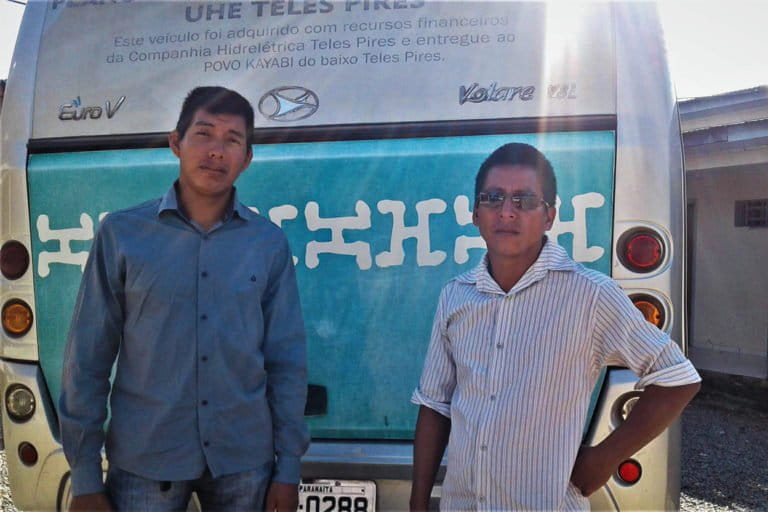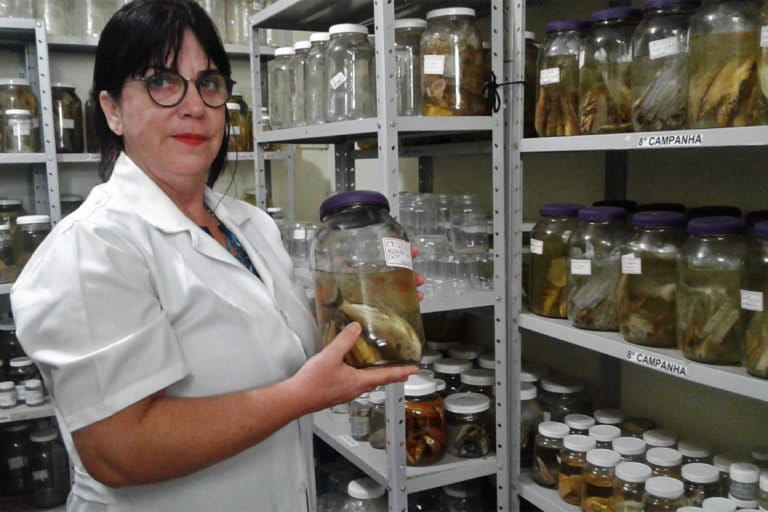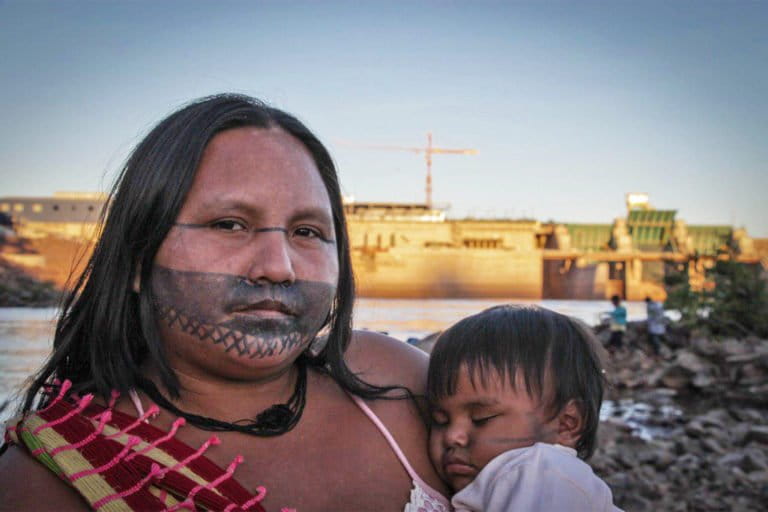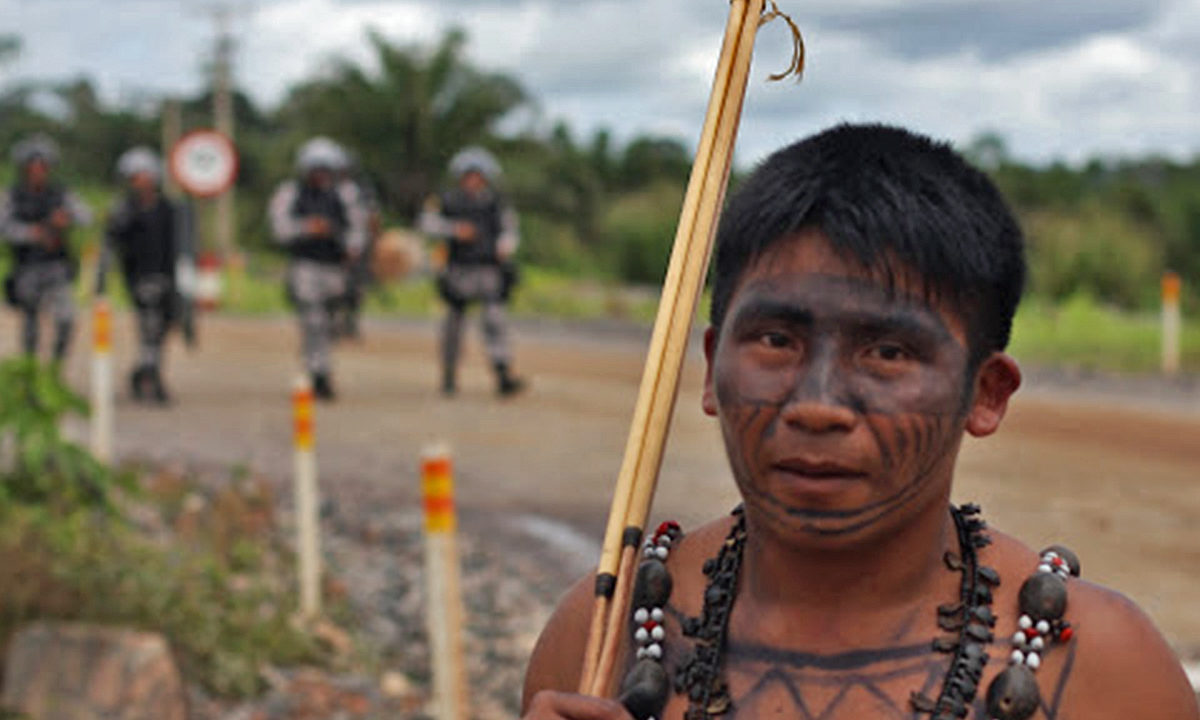- Villagers living near the Teles Pires and São Manoel dams in Brazil’s Mato Grosso state — including the Apiaká, Kayabí and Munduruku peoples — attest to poor water quality, lack of potable water, increased malaria and rashes since the dams were built on their river. They also say there has been little response from the dam companies.
- Indigenous peoples say the Brazilian hydroelectric projects have altered river ecology along with thousands of years of cultural practice, especially their fishing livelihood. Migratory fish and other game fish have been greatly diminished, so residents must now resort to fishing at night.
- Once the COVID-19 pandemic arrived in the region, lack of clean water for bathing became even more urgent, while disappearing fish in daily diets made it harder to get food or isolate in riverside villages. Only under judicial order did dam companies recently improve water supply infrastructure.
- Experts trace these adverse impacts back to the dams’ planning stages: with the construction companies skipping legally mandated steps, not consulting Indigenous peoples as required, and failing to calculate cumulative impacts of multiple dam projects. Villagers are now monitoring impacts — and some are studying the law.
The waters of the Teles Pires River once ran so clear that Indigenous riverine villagers could fish with bow and arrow, just as their Amazonian ancestors did, and also drink safely directly from the stream, say the Apiaká, Kayabi and Munduruku peoples.
Then came the Teles Pires dam, constructed from 2011-2014, and then the São Manoel dam, which received its operating license in 2017, filling its reservoir in 2018. Afterward, water quality deteriorated, with residents reporting “dirty, polluted, muddy” water. It carried sediment, organic matter from inundated decomposing trees and vegetation, such as the toxic vine timbó, that wasn’t previously removed — plus pesticide runoff from upstream soy plantations that have replaced the rainforest.
This drastic decline in water quality impacted Indigenous health near the Teles Pires dams, with traditional communities seeing a rise in malaria due to mosquitoes breeding in stagnant pools caused by the dams’ varying flows.

There’s also been a rise in skin rashes and diarrhea, which Indigenous residents say results from bathing in, and drinking, the now-polluted river water.
Equally concerning: migratory fish decreased, and became difficult to find in the murky river waters, greatly increasing Indigenous food insecurity.
Modern inroads, modern ills
The coming of the dams brought other economic and environmental woes to the once forest-protected villages, including rapidly encroaching deforestation and expanding agribusiness and mining.
This made it harder for Indigenous peoples along the Teles Pires River to isolate themselves from the effects of the global pandemic when it hit.
Undergraduate law student Diego Paleci Kayabi, of the Kayabi Indigenous people, told Mongabay that everyone in his village of Kururuzinho, near the dams, had contracted COVID-19. Diego and teacher Arlindo Kayabi explained that by using forest home remedies, they avoided COVID deaths, though long-term effects of the virus remain to be seen.

Similar impacts of Amazon Basin hydroelectric dams on fish, water quality and health have been reported on the Xingu River as a result of the Belo Monte dam; on the Madeira River due to the Santo Antônio and Jirau dams; and dozens more.
The four mega dams on the Teles Pires River — the Teles Pires, Colíder, São Manoel and Sinop dams — built along a 400-kilometer (250-mile) stretch of river, without mandated prior consultation of Indigenous residents or cumulative impacts analysis — have disrupted traditional community governance and food sovereignty.
So when the pandemic brought a health crisis necessitating access to clean water, along with a rise in Brazilian foodstuff prices, it hit hard in dam-adjacent communities already struggling with degraded water and food security.
Brent Millikan of NGO International Rivers says, “The Teles Pires is so important, with four dams. The impacts around [them] increasing land speculation and deforestation, attacks on sacred places of indigenous peoples, have been huge.”
All of this made residents more susceptible to knock-on effects when the pandemic hit, Millikan says: “You have impacts of hydro projects on food security and income and health problems, you’ve got a precarious health system. [This] makes [Indigenous peoples] more vulnerable to other predatory actions like gold mining.”
“Land grabbers” invading their Kayabi territory, says Diego Paleci, “keep knocking down more and more trees,” not stopping for the pandemic. Have the Kayabi reached out to politicians? “Yes, but the politicians support it, so they don’t do anything.”

Water impacts: ‘You come out dirtier’
Dorivan Kirixi of the Munduruku people, like Diego Paleci, studied law in university. Dorivan told Mongabay in a 2018 interview, soon after the dam construction, how the Teles Pires River was always “transparent and clean [in the past but] now, everything has changed. The water is dirty … It affects the village.”
In Dorivan’s hamlet of Papagaio (Parrot), “There’s a bad smell to the water,” and when residents bathe there, “You come out dirtier than when you entered. But we keep using the river to bathe because there’s no other way to [get clean]. Even knowing we could get sick, or get itchy rashes or serious wounds.”
Although they’ve lodged complaints, Dorivan says, in 2021 the river is “only more and more polluted.”
“The water quality is bad, contaminated with bacteria,” agrees local disease prevention agent Sandro Waro. Since the dams were built, there’s “a fungus that appears on the skin after bathing. Sometimes, [people’s] skin begins to peel off.” He says an ointment can be applied to reduce the fungus, “but it doesn’t make it disappear.”
Those rashes aren’t always temporary. “For some people, once they get a skin rash, it stays there,” Dorivan Kirixi adds, “like a tattoo.”
After drinking river water, some contract diarrhea. The Teles Pires, which once ran clear, is cloudier, filled with “filth,” Dorivan Kirixi says. Increased sediment load results from the dams’ backing up the river’s flow, while stagnant water breeds bacteria.
“We don’t drink water from the river whereas before we did,” Dorivan Kirixi adds.

Company-provided wells inadequate
When the dam operators did try to fix the freshwater problem, Dorivan Kirixi says, they didn’t install wells equitably among riverine towns. Some small villages didn’t get a well at all, he says, and while some families now have well access, others don’t, resulting in social division and enmity.
Having a well still doesn’t guarantee clean water. Millikan recalls that the dams’ environmental impact plans required the companies to drill wells to provide clean drinking water. “But the Teles Pires and São Manoel consortiums did things on the cheap.”
Millikan observed these problems up close in March 2020 on an inspection trip organized by the federal prosecutor’s office. “Wells were not done properly, weren’t drilled to the proper depth, for example, so [in 2020] some were drying up, not reaching down to the water table. Some wells became contaminated. The companies [also] installed cheap PVC pipes for water distribution to houses,” Millikan says. “A lot are breaking, so there was seepage of contaminated water.”
On Dec. 2, 2020, after 10 years, Indigenous residents got their first-ever public audience, expressing impacts on water and fish. On Dec. 18, a judge ordered water infrastructure improvements to dam-affected villages.
Dorivan’s Papagaio village was one of them.
But “internal divisions,” created by a decade of the companies’ unequal interventions, persist, Diego Paleci notes.

Dead fish and a ‘schizophrenic’ river
“We don’t see the fish that we used to see,” Dorivan Kirixi says. “Every day [floating] dead fish pass by — jaú, pirarara, pintado, cachara.” Villagers also report dead Amazon freshwater dolphins floating by about once a week, and dead river turtles. This didn’t happen before the dams were built, villagers say. High aquatic mortality likely now occurs due to low oxygen levels and eutrophication.
“We observe the losses in many species,” Sandro Waro says, including “piraiba, pirarara, pintado, and tambacu,” all once an important part of local diets.
Biologist Solange Arrolho, of Mato Grosso State University, confirmed: “Migratory fish species have diminished since the dams’ implantation: matrinxã, jaú, cachara, piraíba, pirarara, and various species of pacus.”

“The Teles Pires has been transformed from a seasonal river to a schizophrenic river,” Millikan says. The dams’ run-of-river design was touted as less impactful, but “they turn [the river] on for a few hours, then turn it off,” disorienting the fish.
Upstream, daily oscillations of water flows trick fish into migrating into temporarily flooded forest pools, only to be “imprisoned” when engineers drop levels down. “The fish die there in the forest,” Diego Paleci says.
Since fish “can’t pass by the [dams’] turbines,” Dorivan adds, “they’re dying [there too].” An April 2021 report recommends protections around turbines to help staunch dam-caused Brazilian fish mortality; an estimated “128 million kilos of fish [died] in the last ten years.”
Dam operators Companhia Hidrelétrica Teles Pires (CHTP) and Empresa de Energia São Manoel (EESM) did not answer requests for comments.

Night fishing ‘where the fish sleep’
“The harms from the dams are biological, social,” and importantly, “cultural,” Diego Paleci stresses, weakening traditional culture.
Sandro Waro recounts the loss of the ancient Indigenous art of fishing during daytime with bow and arrow in clear water. Sediment-laden Teles Pires waters now prevent this. In his village, “During the day, we hardly encounter anything,” Waro explains. So “we can get fish only at night.”
Diego Paleci recounts nocturnal fishing trips using three-pronged spears and air-loaded harpoons. That’s particularly needed from June to September, he says, when lower natural flows combine with the dams’ flow reductions.
Dorivan Kirixi concurs: “The dam has made it difficult to fish. Before the dam, we’d fish from the riverside and get 10 to 20 fish. Now, the people in the village can’t rest.” Not finding enough fish by day, “we fish at night on the side of the river.” Villagers now must travel around 20 minutes by motorized canoe “to go where the fish sleep on the side of the river underneath fallen branches. We dive into the river, 2 meters down and use a fish hook.”

Fishing in this way is not easy, since it is done at night, from around 7 p.m. to 3 a.m. To see, fisherfolk use lanterns. “If they don’t get any, they keep going [later into the night],” Dorivan Kirixi says. This newly adopted fishing method arose out of necessity, but still doesn’t provide a steady, plentiful food source as in the past. When they’re lucky, Dorivan Kirixi says, villagers only find caxara, pirarara or piranha fish.
Sometimes now, people go hungry. “Some families are hungry because of the low catch of fish,” Waro says. “They try to make up [the food deficit] with the roça,” their gardens. They are also trying to grow more “sugarcane, pineapple, potato, banana and cará.” But these dietary changes raise the question of whether families are experiencing nutritional deficits.
Since the pandemic, more families are going hungry, Dorivan Kirixi says.
Flawed dams planning
Millikan and Simone Athayde, an environmental anthropologist at Florida International University, say the interconnected problems with water and food security, and Indigenous health, could have been averted with adaptive integrated management strategies in the multiple dams’ planning stages. But impact reports for each dam didn’t calculate the cumulative ecosystem and community impacts of four dams.
Since the dam companies designed their basic plans for the communities without prior consultation of Indigenous peoples, Millikan says, “You’ve got lopsided relationships. The company just comes in and does what it wants, puts in a school, manioc preparation house, in the villages. This undermines the authority of the traditional councils [and circumvents them] with Basic Plan councils created by the company. They make a parallel decision-making structure. It’s easier for them to control things that way, and further impacts relationships in the social community.”
Athayde explains, “Companies hired to build the [dams] present the lowest budget, use the lowest-quality materials, trying to get the best cost-benefit with their investment. This exacerbates impacts with very low-quality infrastructure.”


Fisherfolk and experts demanded a fish ladder so migratory fish could continue passing through the Sete Quedas rapids. But CHTP, claiming fish didn’t migrate through them, refused to build a ladder, ichthyologist Francisco Machado told Mongabay.
São Manoel’s EESM followed suit, so fish were caught in the gap between the two dams, unable to migrate.
Documenting disappearing fish
Biologist Arrolho once worked for the Teles Pires dam company on its fish monitoring team. There, she documented fish “disappearing” near the dams. But, Arrolho says, the dam company fired her for making her reports.
Arrolho describes how the Teles Pires River dams diminished fish that traditionally swam and reproduced there. Matrinxã and pacu, for example, feed on fruit. But when dams flood forested areas for extended periods, trees die, no longer feeding the fish that depend on them, Arrolho says.

Resident Darlisson Apiaká, of the Apiaká people, confirmed a post-dam construction world with “a narrower river” where “fruits [are] falling on dry soil” instead of into fishes’ mouths.
Arrolho sketched the dams’ area, noting: “Lots of piraiba and pirarara died and so they don’t come near the dams anymore. They stop reproducing.” She says their diet consists of smaller fish, but with those fish dying, the piraiba and pirarara “have nothing to eat.”
In 2018, residents told Mongabay that terrestrial animals, too, were killed by the dams.
Diego Paleci, a teenager when the reservoirs filled up, recalled the horror of watching animals taken by rising water. Later, Sandro Waro says, animals died from sudden, unpredictable changes in river levels, going “from 50 centimeters [20 inches], until it’s one meter [40 inches],” for example, drowning “armadillos, wild forest pigs, jabuti tortoises” trying to cross the river.
Arlindo Kayabi, the teacher, says that early on, animals the Kayabi traditionally hunt were being killed, especially wild pigs and tapir, both by the turbines and by the dams’ sudden releases, which he described as a “huge current [that] breaks the bones of the animals.” Now, in 2021, Arlindo and Diego report fewer deaths among scarcer terrestrial animals.

Pressure on consultants, and independent monitoring
Despite all this anecdotal testimony, independent scientific data on impacts to fish, terrestrial animals and communities has been hard to come by.
Like Arrolho, who says she was fired by the Teles Pires dam company for reporting disappearing fish populations near the dams, Adriano Castorino of the Federal University of Tocantins recounts a similar experience.
In 2011, the anthropologist was hired to interview ribeirinhos (non-Indigenous traditional fisherfolk) for the dam’s environmental impact report. “I spent three months going house to house, letting [riverine people] talk comfortably, taking photos. The company got nervous. They [feared] we would politicize the [fisherfolk].” Tensions grew as “[w]e disagreed with the way the company proceeded. They didn’t want to consider [data collected about] ribeirinhos who lived on [mid-river] islands.”
In 2013, “the company threw my team out,” terminating the contract and hiring another team from Belo Horizonte. “They did the study sob encomenda [to order], wrote what the company contracted to hear,” Castorino says.

“You’re so dependent on the companies for data,” Millikan says, “so we’ve been working with the MPF [federal prosecutor’s office] and MAB [association of dam-affected peoples] to do independent monitoring, inspections on the [dams’] cumulative impacts of water quality, turtles and fish for food security, how dams are being operated … We’d like a robust monitoring system.”
He suggests the companies should finance independent monitoring by “deposit[ing] money into funds, administered by the Teles Pires Fórum, universities, or the MPF.”
“We’re trying to … avoid additional damage,” Millikan says. “There’s a need for compensation, not just money, but the rights of local peoples, transparency, have them involved.”
Studying law to defend Indigenous rights
Simone Athayde concurs: “Local people can monitor the compliance system, the accountability of projects, and denounce problems.”
Dorivan Kirixi and Diego Paleci, both majoring in law, plan to do exactly that. When Mongabay first met Dorivan Kirixi in 2018, he was considering quitting law school. When the pandemic turned university classes remote, he dropped out and went back to Papagaio. But he’ll return to university next term, convinced law is the tool to defend his people: “The companies never compensated for what they caused; some demands of communities are unresolved. I’m never going to stop fighting for my rights.”

Diego Paleci recounts what he calls “shady moves” by the dam companies: not returning phone calls and emails documenting problems they’re mandated to fix. Combined with pandemic-shuttered offices, it meant months of delayed resolution.
This just motivates Diego Paleci even more to finish his law studies, he says. It’s a language he hopes the companies will have to obey.
Banner image: An Indigenous protestor at the Belo Monte dam site on the Xingu River in 2013. Indigenous groups on the Xingu suffered many of the same socio-environmental problems and abuses as experienced by Indigenous people on the Teles Pires River, according to evidence and complaints. Image by Ruy Sposati/Agência Raízes via International Rivers via Flickr (CC BY-NC-SA 2.0).
FEEDBACK: Use this form to send a message to the author of this post. If you want to post a public comment, you can do that at the bottom of the page.
